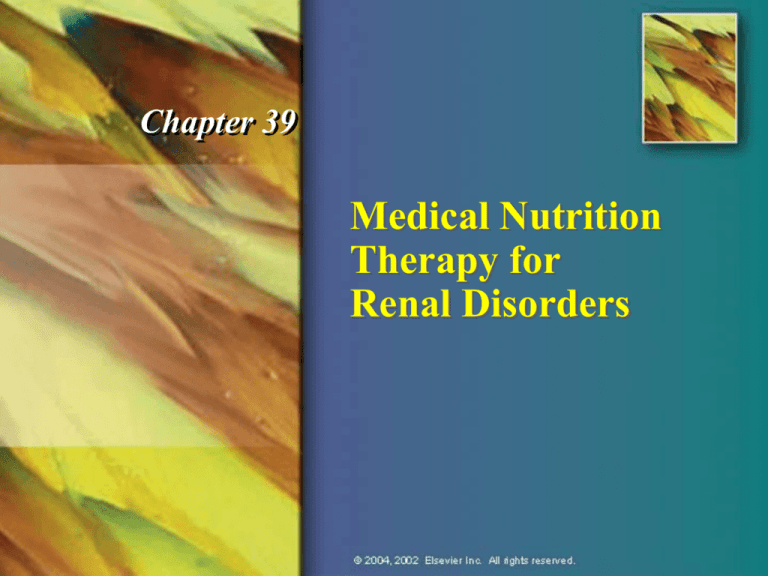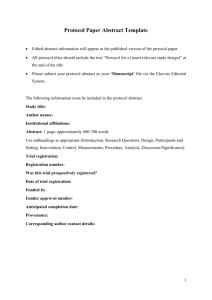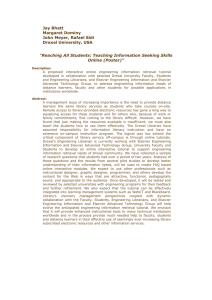
Chapter 39
Medical Nutrition
Therapy for
Renal Disorders
Kidney
Function
—Maintain homeostatic balance with
respect to fluids, electrolytes, and organic
solutes
© 2004, 2002 Elsevier Inc. All rights reserved.
The Nephron
© 2004, 2002 Elsevier Inc. All rights reserved.
Kidney Diseases
Glomerular diseases
1. Nephrotic syndrome
2. Nephritic syndrome—tubular or interstitial
3. Acute renal failure (ARF)
4. Tubular defects
Other
5. End-stage renal disease (ESRD)
6. Kidney stones
© 2004, 2002 Elsevier Inc. All rights reserved.
Changes in Nephrotic Syndrome
Edema
Proteinuria
Hypoalbuminemia
(hypoproteinemia in general)
Hypercholesterolemia
Hypercoagulability
Abnormal bone metabolism
© 2004, 2002 Elsevier Inc. All rights reserved.
Kidney Diseases
1. Nephrotic syndrome: may be caused by diabetes mellitus
(DM), systemic lupus erythematosus (SLE), amyloidosis
Diet: Protein 0.8 to 1 g/kg IBW 80% HBV
Kcal 35 to 40/kg IBW
Phosphorus 8 to 12 mg/kg IBW
Sodium 1to 3 g/day
Potassium unrestricted
Fluid unrestricted
Calcium 1200 to 1400 mg/day
From: National Renal Diet: Professional Guide, 1993
© 2004, 2002 Elsevier Inc. All rights reserved.
Kidney Diseases—cont’d
2. Nephritic syndrome: acute
glomerulonephritis
Occurs after streptococcus infections
Symptoms:
Hematuria
Hypertension
© 2004, 2002 Elsevier Inc. All rights reserved.
Kidney Diseases—cont’d
3. Nephritic syndrome
—Diet to treat underlying disease
—Restrict diet to control symptoms
—Protein restricted in uremia
—Sodium restrict in hypertension
—Potassium restrict in hyperkalemia
© 2004, 2002 Elsevier Inc. All rights reserved.
Acute Renal Failure—Cause
Algorithm content developed by John Anderson, PhD, and Sanford C. Garner, PhD, 2000.
© 2004, 2002 Elsevier Inc. All rights reserved.
Acute Renal Failure—Pathophysiology
Algorithm content developed by John Anderson, PhD, and Sanford C. Garner, PhD, 2000.
© 2004, 2002 Elsevier Inc. All rights reserved.
Acute Renal Failure—Medical and Nutritional
Management
TPN, Total parenteral nutrition.
Algorithm content developed by John Anderson, PhD, and Sanford C. Garner, PhD, 2000.
© 2004, 2002 Elsevier Inc. All rights reserved.
Sample Calculation of Fluid Requirements in
Acute Renal Failure
© 2004, 2002 Elsevier Inc. All rights reserved.
Summary of Medical Nutrition Therapy for
Acute Renal Failure
GFR, Glomerular filtration rate; HBV, high biologic value; IBW, ideal body weight.
© 2004, 2002 Elsevier Inc. All rights reserved.
Progression to End-Stage Renal
Disease (ESRD)
First
Decline in glomerular filtration rate (GFR)
Second
Adaptations in renal function, i.e.,
increase in GFR
Third
Adaptations work in the short term to
improve renal function.
Fourth
In the long run a loss of nephron units
occurs.
Fifth
A slow but progressive decline in renal
function
Sixth
Eventually this decline leads to renal
insufficiency, i.e., ESRD
© 2004, 2002 Elsevier Inc. All rights reserved.
End-Stage Renal Disease—Cause
Algorithm content developed by John Anderson, PhD, and Sanford C. Garner, PhD, 2000.
© 2004, 2002 Elsevier Inc. All rights reserved.
End-Stage Renal Disease—Pathophysiology
Algorithm content developed by John Anderson, PhD, and Sanford C. Garner, PhD, 2000.
© 2004, 2002 Elsevier Inc. All rights reserved.
End-Stage Renal Disease—Medical and
Nutritional Management
Algorithm content developed by John Anderson, PhD, and Sanford C. Garner, PhD, 2000. Updated by Katy G. Wilkens, 2002.
© 2004, 2002 Elsevier Inc. All rights reserved.
Comparison of Treatments
Pre-ESRD, Hemodialysis, Peritoneal Dialysis
Treatment
Pre-ESRD
Hemodialysis
CAPD or CCPD
Diet and
medications
Diet and medications
Hemodialysis
Vascular access
Diet and
medications
Peritoneal
dialysis
Peritoneal membrane
Modality
Duration
Indefinite
3-5 h
2-3 d/wk
3-5 exchanges
7 d/wk
Concerns
Glomerular
hyperfiltration:
BUN:
bone disease:
HTN:
Glucose control in
diabetes
AA loss;
interdialytic
electrolyte and
fluid changes:
Bone disease:
HTN
Protein loss:
glucose absorption:
Bone disease:
weight gain:
hyperlipidemia:
glucose control in diabetes
© 2004, 2002 Elsevier Inc. All rights reserved.
General MNT for Pre-ESRD,
Hemodialysis, Peritoneal Dialysis
Pre-ESRD
Hemodialysis
CAPD or CCPD
Protein
(g/kg IBW)
0.6-0.8
1.1-1.4
1.2-1.5
Energy
35-40
30-35
25-35
<17
<17
1000-3000
2000-3000
2000-4000
Unrestricted
~ 40
Unrestricted
Unrestricted
500-750 +
2000 +
(kcal/kg IBW)
Phosphorus8-12
(mg/kg IBW)
Sodium
(mg/d)
Potassium
(mg/kg IBW)
Fluid
(ml/d)
urine output
(1000 if anuric)
Calcium
1200-1600
(mg/d)
Use adjusted IBW if obese
© 2004, 2002 Elsevier Inc. All rights reserved.
based on serum
based on serum
level
level
Adjusted Body Weight
Adjusted IBW for obesity
Female
([actual wt – IBW] x 0.32) + IBW
Male
([actual wt – IBW] x 0.38) + IBW
© 2004, 2002 Elsevier Inc. All rights reserved.
Recommendations for Dietary
Protein Intake
In Patients with Progressive Renal Disease
A. GFR >55 ml/min
B. 25< GFR <55 ml/min
0.8 mg/day
0.6 mg/day
© 2004, 2002 Elsevier Inc. All rights reserved.
Glucose Kcal from Dialysate
Glucose in dialysate
1.5% = 15 g/L
2.5% = 25 g/L
4.25% = 43 g/L
1. L of % solution x g/L glucose = g glucose
2. Repeat for each glucose concentration used
3. Total g glucose for all exchanges
4. 0.80 x total g glucose = g glucose absorbed
5. g glucose absorbed x 3.7 kcal/g = kcal
© 2004, 2002 Elsevier Inc. All rights reserved.
Monitor Patient Status
1. BP >140/90
2. Edema
3. Weight changes
4. Urine output
5. Urine analysis:
—Albumin
—Protein
© 2004, 2002 Elsevier Inc. All rights reserved.
Monitor Patient Status—cont’d
6. Kidney function
Creatinine clearance
Glomerular filtration rate (GFR)
7. Blood values
BUN 10 to 20 mg/dl (<100 mg/dl)
Creatinine 0.7 to 1.5 mg/dl (10-15 mg/dl)
Potassium 3.5 to 5.5 mEq/L
Phosphorus 3.0 to 4.5 mg/dl
Albumin 3.5-5.5 g/dl
Calcium 9-11 mg/dl
© 2004, 2002 Elsevier Inc. All rights reserved.
Uremia, a Clinical Syndrome—
Signs and Symptoms
Malaise
Weakness
Nausea and vomiting
Muscle cramps
Itching
Metallic taste (mouth)
Neurologic impairment
© 2004, 2002 Elsevier Inc. All rights reserved.
Skeletal Effects of Chronic
Renal Failure
Hyperphosphatemia
Hypocalcemia
Hyperparathyroidism
Low bone mass and density
Osteitis fibrosa cystica—hyperplastic
demineralized bone
© 2004, 2002 Elsevier Inc. All rights reserved.
Regimen for Total Parenteral Nutrition by
Subclavian Vein for Dialysis Patients
Developed by Katy Wilkens, RD, Northwest Kidney Center; Seattle, Wash.
* Additional volume may include insulin and vitamins.
© 2004, 2002 Elsevier Inc. All rights reserved.
Regimen for Intermittent Parenteral Nutrition
Administered During Hemodialysis Therapy
Developed by Katy Wilkens, RD, Northwest Kidney Center; Seattle, Wash.
* Additional volume may include insulin and vitamins.
© 2004, 2002 Elsevier Inc. All rights reserved.
Kidney Transplant
1. Types: related donor or cadaver
2. Posttransplant management:
Corticosteroids
Cyclosporine
3. Diet while on high-dose steroids:
1.3 to 2 g/kg BW protein
30 to 35 kcal/kg BW energy
80 to 100 mEq Na
4. Diet after steroids:
1 g/kg BW protein
Kcal to achieve IBW
Individualize Na level
© 2004, 2002 Elsevier Inc. All rights reserved.
Kidney Stones
1. Particulate matter crystallizes
Ca salts (Ca oxalate or Ca phosphate)
Uric acid
Cystine
Struvite (NH4, magnesium and phosphate)
2. Ca salts in stones—Rx: high fluid; evaluate
calcium from diet; may need more!
3. Treat metabolic problem; low-oxalate diet
may be needed; acid-ash diet is sometimes
useful but not proven totally effective
© 2004, 2002 Elsevier Inc. All rights reserved.
Kidney Stones—cont’d
4. Uric acid stones
Alter pH of urine to more alkaline
Use high-alkaline-ash diet
Food list in Krause text
5. Cystine stones (rare)
6. Struvite antibiotics and/or surgery
© 2004, 2002 Elsevier Inc. All rights reserved.
Acid-Ash Diet
Increases acidity of urine (contains
chloride, phosphorus, and sulfur)
Meats, cheese, grains emphasized
Fruits and vegetables limited (exceptions
are corn, lentils, cranberries, plums,
prunes)
© 2004, 2002 Elsevier Inc. All rights reserved.
Alkaline-Ash Diet
Increases alkalinity of urine (contains
sodium, potassium, calcium, and
magnesium)
Fruits and vegetables emphasized
(exceptions are corn, lentils, cranberries,
plums, prunes)
Meats and grains limited
© 2004, 2002 Elsevier Inc. All rights reserved.
Summary
Renal diseases—delicate balance of
nutrients
Regular monitoring of lab values, with
altered dietary interventions accordingly
© 2004, 2002 Elsevier Inc. All rights reserved.




